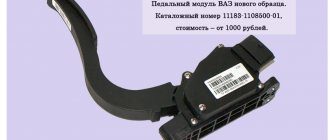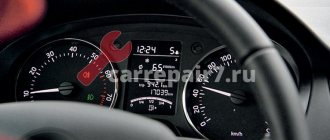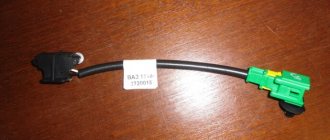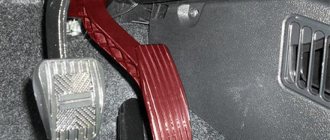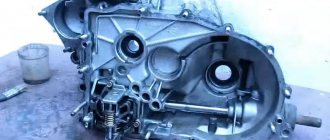09 February 2015 Lada.Online 244 589 96
In order for the car to comply with more stringent environmental standards, AVTOVAZ equips modern Lada cars (Priora, Granta, Kalina, Niva, Largus, Vesta and XRAY) with an electronic gas pedal or “E-gas”. The throttle valve drive got rid of the cable and became equipped with a gear motor. As a result, the gas pedal has no mechanical connection with the throttle valve, and engine control has become completely electronic.
Unstable idle speed
Have you encountered engine problems when the car stalls in traffic jams or the engine speed is unstable? There may be several reasons for these malfunctions. It is recommended to start searching for a problem with diagnostics, and if this is not possible, then first perform a check, and only then change the faulty parts.
AvtoVAZ installs the same type of engines on modern Lada cars (Kalina, Granta, Priora, Largus, Vesta, Niva or XRAY), so the solution to problems for all these cars is similar.
The idle speed fluctuates, the engine stalls when moving (on the move) or at a standstill, the reasons may be the following:
- The engine air filter is clogged.
- The spark plugs are faulty.
- High voltage wires are faulty.
- Ignition module/coils are faulty.
- The idle air control (IAC) or its electrical circuits are faulty.
- The throttle position sensor (TPS) is faulty or the throttle assembly is dirty.
- The mass air flow sensor (MAF) is not working.
- The oxygen sensor (OS) or circuits are faulty.
- There is insufficient pressure in the fuel rail.
- Compression in the cylinders is low.
- The exhaust system is leaking.
- Air leaks through the crankcase ventilation hoses and the hose connecting the intake pipe to the vacuum brake booster.
- The cylinder head gasket is damaged.
- The timing belt or tension roller is worn.
- The camshaft cams are worn.
- The valve timing is off. Check the alignment of the marks on the crankshaft and camshaft.
- The engine control unit (ECU) or its circuits are faulty.
Have you encountered floating engine speeds? What was the cause of the malfunction? We solve such engine problems in the comments or on the forum. Let us remind you that along with unstable speed there may be other problems, for example, the engine is difficult to start.
The Lada Kalina idle speed sensor or IAC is a device that is responsible for the necessary air supply to the internal combustion engine when it is idling (in the absence of pressure on the gas pedal). For example, the driver releases the accelerator pedal and the air supply to the internal combustion engine stops. To prevent the engine from stalling, the idle speed sensor comes into operation, which is involved in the process of supplying the required amount of air bypassing the throttle assembly.
In other words, the IAC is a kind of valve-regulator. It is very important for every car owner to know and understand the principles of operation of the product, because if it breaks down, in most cases the car’s self-diagnosis system does not determine the reason for the incorrect operation of the engine.
Priora - why the speed fluctuates
If the speed on a Priora with E-gas fluctuates, or the warm-up speed disappears, this means that the sensors are not working correctly, “the contact is coming off”. The sensor does not constantly send signals to the electronic control unit, and therefore the ECU acts proactively - it sends commands to the gearbox to close/open the damper. Any diagnostics will show a malfunction of one of the sensors, and first it’s worth looking at its contacts to see if they have become acidic, if the wires are coming off, etc. And if the situation with them is irreparable, you will have to change the sensor.
Idle speed regulator Lada Kalina and its device
- a housing in which a stepper motor is located with two windings independent of each other, rotor supports (rear and front);
- valve shut-off needle and spring;
- power connector.
3 main functions of the controller
1. In addition to maintaining the required engine speed, the device ensures its proper operation under cold start conditions (warming up at sub-zero air temperatures). In this case, the regulator provides higher engine speeds until the latter warms up to operating temperature. 2. The second important function that many drivers don’t even think about is the speed maintenance mode without pressing the gas pedal. In other words, ensuring the engine operates at idle speed is the merit of the IAC. 3. The third and very important purpose of the product is to ensure the creation of an air-fuel mixture of the required concentration and saturation. This feature has a positive effect on final fuel consumption and smooth engine operation.
Where is the idle speed sensor on Kalina
Due to its purpose, the product is located directly in the throttle assembly next to the throttle position sensor.
Signs indicating malfunctions
Some signs indicating improper operation of the unit: - problems with starting the engine (it is possible to start only by repeatedly pressing the gas pedal); — floating speed when switching gears to neutral; — when changing gears, the car stalls completely or choke; — it is difficult to warm up the engine in the cold season (engine speed does not increase above 1500 rpm); — when additional energy consumers are turned on (stove, air conditioning, heating and others), the idle speed is lower than the operating values, or constantly floats.
If you observe one or more of the above situations, pay attention to the idle speed sensor for the 8 valve Kalina and carry out diagnostic measures.
Product delivery options
Note! Below are the shipping methods available specifically for this product. Payment options may vary depending on the shipping method. Detailed information can be found on the “Delivery and Payment” page.
Parcel by Russian Post
Available payment methods:
- Cash on delivery (payment upon receipt)
- Using cards Sberbank, VTB, Post Bank, Tinkoff
- Yandex money
- QIWI
- ROBOKASSA
Parcel by Russian Post 1st class
Available payment methods:
- Cash on delivery (payment upon receipt)
- Using cards Sberbank, VTB, Post Bank, Tinkoff
- Yandex money
- QIWI
- ROBOKASSA
Express Parcel EMS
Available payment methods:
- Cash on delivery (payment upon receipt)
- Using cards Sberbank, VTB, Post Bank, Tinkoff
- Yandex money
- QIWI
- ROBOKASSA
Transport companies
Available payment methods:
- Using cards Sberbank, VTB, Post Bank, Tinkoff
- Yandex money
- QIWI
- ROBOKASSA
Courier delivery in TogliattiAvailable payment methods:
Delivery time from 1 to 12 hours. Pickup from our warehouseAvailable payment methods:
Pickup times must coincide with store opening hours. |
Examination
3 popular ways to diagnose the causes of a malfunction
Among professionals and car enthusiasts, there are many ways to check the performance of the sensor. But we will dwell in detail only on the most effective and simple methods:
- First method. The point of this method is to check the operation of the sensor itself. To do this, you need to remove the product from its mounting location, take it in your hand, connect the power contact block to it (if it is not connected) and start the car engine. In this case, on a working device, when the engine starts, the sensor needle should extend. If this does not happen, then its operation is impaired or the device is faulty.
- Second method. Assumes the use of a voltmeter. The task is to check that the correct voltage is supplied to the sensor. To do this, the sensor is disconnected from the contact chip, and a measuring device is connected to its terminals. After which, the ignition is turned on, and all the terminals of the contact chip are analyzed one by one. The operating resistance parameters should be about fifty ohms or tend to infinity. The voltage level should be 12 volts. If the voltage reading is less, this indicates improper operation of the battery or the cause is related to an open circuit or operation of the computer.
- The third approach involves checking the resistance of the external and internal windings of the sensor. Measuring work should be done using a multimeter. The contact parameters after measurements should be in the range from 40 to 80 Ohms. If there is a deviation or zero values of the device during measurements, the IAC must be replaced.
Replacing the idle speed sensor on Kalina
The operation of installing or removing the product is not particularly difficult and is accessible to any car owner, regardless of the level of training, under almost any conditions. Replacement is carried out in the following sequence: 1. First step. During any work related to the vehicle's electrical system, the on-board system is de-energized (to do this, simply disconnect the battery terminal). 2. Second step. We find the regulator and disconnect the contact block with the supply wires from its body. 3. Third step. Using a long Phillips screwdriver, unscrew the mounting screws (2 pieces) and remove the product from the car’s throttle body. 4. We install the new product, the procedure is similar to the removal process only in reverse order. The new sensor does not require adjustment or configuration.
Measures to extend the service life of IACs
It should be noted that it is not always necessary to immediately replace the idle air regulator for an 8-valve Kalina with a new device. Quite often, its proper operation is prevented by banal contamination with oils and tar deposits contained in crankcase gases. Therefore, to restore the performance of the IAC and extend its service life, it is necessary to periodically clean the cone needle and the spring of the product from contamination. In addition, the installation hole itself in the throttle assembly must be cleaned. If you follow the above recommendations, the device will not fail at the most crucial moment and will last for a long time.
In the morning at -1, the revs on the tachometer are first 500, and after 1-2-3 seconds the warm-up speed is 1100. I changed the wires, changed the idle, changed the TPS, changed the spark plugs, changed the coil, called with a multimeter. I checked the DMRV readings 0.98. I installed a new air filter. I changed the idle sensor, removed the throttle, it was clean.
And still the relay makes one click and from 500 it is set to 1100, as it warms up everything is fine, then it is set to 900 and it starts without any hang-ups. I don’t know where to dig, what to look for?
The firmware has not changed, original Bosch. I don’t really know what the numbers are, just if you can write something. I’m already thinking, maybe there’s something wrong with the firmware during a cold start? So the main thing is that it warms up for 1 minute, I turn it off, start it again, this is no longer the case. It’s just some kind of trouble, and if the frost hits -30, it will completely shut down, well, in general, such things.
- At XX, the engine runs intermittently in the Lada Kalina - 7 answers
- VAZ Kalina stalls 2-4 seconds after starting – 6 answers
- It revs itself in the morning at idle, Kalina – 6 answers
- The idle speed on the VAZ Kalina jumped up - 6 answers
- VAZ Kalina stalls when cold or in the cold - 5 answers
If the engine is already running and produces 500 rpm. Then for some reason the relay clicks, right? There the IAC can only click, then yes, the speed will change if it is faulty. Do you have an IAC or a throttle assembly without it? As for changes in the weather and the dependence of engine operation - this could be due to a faulty mass air flow sensor or just because of the “wrong” air filter.
Which relay clicks? Which relay makes the click?
There in the engine only the IAC can click when starting. And these Russian regulators are of disgusting quality (I bought a new remote control, it was clogged and the heating did not work, and on the new IAC it jammed, replaced it, installed the old IAC and the motor worked fine).
You can read about the same story (about the wrong IAC) here.
You don’t have to bother with the firmware, you have a normal controller. And you can’t fix this question with firmware.
Source
Cleaning the throttle
To clean the damper from dirt, it is necessary to dismantle it from the car. This will require a number of tools and a little skill in car repair.
Required tool:
- Phillips or flathead screwdriver;
- Pliers;
- Ratchet with extension head 13;
- Carburetor cleaner;
- New gasket for remote control;
All work should be performed with the negative terminal of the battery removed..
Cleaning the mechanical throttle
- We begin to dismantle the damper; to do this, we unscrew the clamp of the air filter corrugation, the clamp of the crankcase ventilation pipe and the clamp from the mass air flow sensor. We take out the corrugation.
- We unscrew the clamps of the throttle heating hoses and lift them up so that the coolant does not leak out.
- Unscrew the clamps of the remaining two hoses from the top and bottom of the DZ.
- Disconnect the TPS and IAC connectors
- Next, unscrew the two bolts securing the DZ, use a ratchet with a head set to “13” and remove the damper. We dismantle the TPS and IAC dampers already removed.
Cleaning process
- Use carburetor cleaner to thoroughly rinse all areas of contamination. Particular attention should be paid to the channels of the idle air regulator, since it is in them that a large amount of dirt accumulates.
- Then we wash the valve itself to remove carbon deposits.
- We carry out assembly in reverse order.
- When assembling, pay special attention to the condition of the sealing ring on the IAC; it should fit tightly to the body and be free of burrs and cracks. Replace it if necessary.
Cleaning the electronic throttle E-GAS
Removing the electronic damper is a little quicker and easier.
IMPORTANT: Do not turn the valve with your fingers; flushing must be done without touching the valve. Otherwise, the mechanism may be damaged, which will lead to inevitable replacement of the remote control.
- We unscrew the clamps of the air corrugation and dismantle it.
- Then remove the connector from the remote control and unscrew the three nuts securing the throttle to the intake manifold.
Cleaning process
- Use carburetor cleaner to clean the throttle from carbon deposits; the cleaned surface should shine.
- We carry out assembly in reverse order.
Reason 1. The food was so-so
The author of the article had a breathtakingly funny story. True, not with him personally, but with a friend. He once filled up with fuel at a well-known gas station. I filled it up and went on a date with the girl. And it’s frosty, winter outside. While we sat in the cafe and cooed at the cinema, it’s time to go home. But there’s no way to get home – the car doesn’t move. Well, no way at all: we haven’t tried everything, we haven’t read what forums. And so, on the advice of an experienced person, my friend decided to stick a branch into the gas tank and check the gasoline. And what do you think? Gasoline is frozen! That is, in general! Apparently the brave mixers overdid it with water in the fuel. Of course, they drove the car away, warmed it up and drained the gasoline, but a residue remained.
conclusions
The main cause of failures are spark plugs, but they are not the only ones that influence the appearance of this effect. Some car enthusiasts may not be able to cope with the occurrence of such malfunctions on their own, and it is necessary to go to a car service center, where they will carry out high-quality diagnostics and also fix the problem. But it is worth considering that you will have to be generous, since neither computer diagnostics nor repairs will cost a penny.
The latest Lada Kalina models come with an electronic gas pedal. Kalina with E-Gas are also equipped with new throttle valves and new ECU controllers - M74 and Bosch M17.9.7.
The gas pedal is electronic; it has no mechanical connection with the throttle valve. The engine control is completely electronic.
The driver, by pressing the gas pedal, only indicates how much acceleration he would like to give to the car, and the engine management system implements this.
The same thing happens when the driver loosens the pressure on the gas pedal, holds it down in one position, or completely removes his foot from the gas pedal.
This system is called “E-gas” (E-GAZ). Engines with such a system can meet EURO IV─V environmental standards.
The electronic gas pedal consists of a plastic lever, which is integral with the pedal and two sensors built into the bracket.
All elements form a single structure, which is sometimes called the gas pedal module.
Each gas pedal position sensor (built into the gas pedal bracket) is a potentiometer, the moving contact of which is rigidly connected to the rotary axis of the pedal lever.
Feedback on the E-Gas modification
Car enthusiasts who have already completed the adjustment note that if you move the pedal assembly cover clockwise, the car becomes a little more lively. If you press the pedal as before and the car starts to move, you have to get used to it and not press the gas so hard. When you press the pedal to the floor, you can't feel the difference.
Those who adjusted the E-gas for a quieter ride noticed that driving on the highway became more comfortable. Now, to maintain speed, you need to press the gas pedal a little harder, which allows your leg to not be as tense as before.
Other motorists do not believe in the positive effect, saying that it is all self-hypnosis. The operation of the electronic gas pedal is based on changing the resistance difference. And even if you move the cover, when the engine starts, the ECU will still consider it to be zero and adjust the throttle from this point. And if you increase the sector stroke, the E-gas error “signal outside the permissible limits!” will appear.
Have you encountered such modification of E-gas? What feedback can you leave about such adjustments? Is there a positive effect or is it all at the level of self-hypnosis? Let us remind you that if necessary, you can check the E-gas yourself. By the way, an alternative to modifying the electronic gas pedal is chip tuning.
What is "failure"? This is an effect in which the car does not accelerate when you press the gas pedal. Usually the failure lasts a few seconds, and then the “jerk” effect occurs. This is a fairly common malfunction associated with the fuel injection system. On Kalina, it does not occur often, but it does happen.
Video about gas failures on an injection engine:
This video material will talk about such a malfunction as gas leaks, the causes of occurrence, methods of elimination, and also contains some recommendations for car owners.
Reason 4. The pressure is so pressure
Look at the manual and decide what pressure is typical for the car. Find the regulator on the line and see if it is leaking. The second reason is incorrect configuration. Excess pressure is generated in the system, which affects the non-standard behavior of the car. Arm yourself with an air pump to check: raise the pressure level to the required level and dump fuel into the tank. The operations must be performed simultaneously. If fuel reset occurs earlier, the regulator should be replaced.
If you have an injection engine, look for the fuel pump in the gasoline tank. With a carburetor engine, the pump is located directly on the engine, under the hood.
Causes of the phenomenon
Drop in speed and failure of the gas pedal
There are few reasons for the phenomenon of “failure” when pressing the gas pedal. It often appears after unsuccessful engine chip tuning and is accompanied by an increase in fuel consumption, but there are other problems directly with injection. So, let’s look at the main reasons for the “failure” effect:
Identifying and eliminating ECU errors
Condition of the candles. On the left the mixture is too rich, on the right it is too lean.
These are all the main reasons that can lead to gas pedal failure.
Dips during acceleration
Once the causes are considered, we can consider how to deal with the problem. So, let’s describe step by step what needs to be done when the gas pedal has dips during acceleration:
- The first step is to check the spark plugs. The appearance of carbon deposits or spark plugs that are too clean indicate that the mixture is not adjusted correctly. It is worth adjusting the correct amount of fuel mixture.
- Ignition wires can also cause the vehicle to malfunction.
- A clogged throttle can lead to failures during acceleration.
- The condition of the air filter affects the formation of the mixture, so it is worth changing it on time.
Air filter clogged
Dirty fuel filter
Dirty fuel filter
- ECU errors can also lead to accelerator failures.
- The last reason is clogged injectors. They need to carry out diagnostics, check functionality, and also clean and replace faulty elements.
Thus, the causes of failures during overclocking have been identified and can be eliminated.
Reason 6. Pressure and air flow sensor
The car does not consume gasoline in its pure form, but converts it into a fuel-air mixture. Its quality determines how well the car will respond to pressing the gas pedal. If the sensors are broken, the calculations to create the optimal mixture will be incorrect, which means the car will lose traction.
Do not assume that a faulty sensor is indicated on the dashboard. If everything were easy, diagnosticians would not be useful as specialists. The car control system is programmed for a short circuit and for wire separation. If the reason is different, then you need to look for the breakdown yourself.
Crankshaft position sensor (CPS)
The crankshaft position sensor is installed under the oil filter. Responsible for reading readings from the crankshaft pulley. The sensor is a fairly reliable element that rarely fails. If the sensor breaks down, the possibility of starting the engine is excluded, since it is this sensor that is involved in sending a signal to the ignition module and generating a spark to ignite the fuel mixture in the combustion chamber.
The main “miscalculations” of VAZ
Of course, no matter how much VAZ praises e-gas, this mechanism also has serious drawbacks. For example, if it fails, this device cannot be repaired. A complete replacement will be required, which will be very expensive. Although today there are “traditional craftsmen” who have adapted to repair the device themselves, this is not always effective - driving with such e-gas is even dangerous.
As for the responsiveness of the car, not everything is clear here either. Many motorists claim that the old Kalinas were much easier to pedal and responded better to pressure. E-gas responds to them with a delay, and this can become a critical problem, especially if you need to quickly avoid a collision or simply quickly overtake.
Repair
If there are any problems with the pedal, then only a complete replacement of the unit will help. But before changing anything, it is worth identifying the cause of the malfunction. To do this, you can use a multimeter test.
You can disconnect the sensors and the block and remove the pedal. Check the resistance - when you press the gas it should change slowly. Jumps in indicators indicate malfunctions.
But sometimes repairs are possible - for example, the wiring is damaged. If a wiring defect is detected, you can use the following diagram.
- Release the axis on which the gear is attached.
- Remove the wiring harness.
- Then the wires are soldered off.
- Release the bracket and pull out the cable.
Next, change the wires and solder them according to the connector under the pedal.
Source
Reason 7. Automatic transmission with surprise
If the car does not pick up speed, and you press hard on the gas, the reason may be in the automatic transmission. At the same time, you can hear that the engine is roaring like a wounded bison, but the power does not reach the wheels. To check if the problem is really in the automatic transmission, do the following:
- Drive onto a flat road without turns. Set the handle to Drive.
- Drive a couple of kilometers, observing the behavior of the car. If when you press the gas, the speed decreases, the problem is in the braking system. If the car does not pull and you hear a loud sound from the engine, then you need to check the automatic transmission.
It will not be possible to close the list with 7 reasons, however, the remaining breakdowns can only be calculated by a master diagnostician. We wish your horse not to break!
We recommend watching:
Road signs additional information pictures with...
How to change the intermediate shaft in the field
The car pulls to the side
It is clear that not only the brakes can be to blame for a car drifting off course - the wheel alignment angles, the wheels themselves, and the steering can also be to blame. However, quite often questions arise specifically about the brakes, especially if the car pulls sideways when braking. Most often, jammed pistons in the cylinders of one of the circuits are to blame. It is possible that the wheel may brake due to the loosening of the bolts securing the pad guide to the steering knuckle, as well as the pads getting oily or getting brake fluid on them.
Perhaps an ice or salt crust has formed on the surface of the pads, or the pads are simply wet. Or one of the circuits of the brake system does not work - the pedal is low and the braking efficiency is low. Brake disc runout, wheel bearing wear, and brake drum out-of-roundness may also be to blame.
Advantages and disadvantages of an electronic pedal
- Instant engine response when you press the gas pedal.
- Smoothing out sharp gas changes.
- Reduced fuel consumption.
- Environmentally friendly.
- Non-repairable.
- Slower acceleration.
- Softer pedal.
What do you think about the electronic gas pedal on Lada cars? Maybe it would be better if the gas pedal has a cable? Let us remind you that some problems with E-Gas are solved after replacing the brake pedal position sensor.
Keywords: granta fret pedals | Lada Priora pedals | fret Kalina pedals | 4x4 pedals | fret vesta pedals | pedals lada xray | fret largus pedals | Niva pedals | universal article
Share on social networks:
Found an error? Select it and press Ctrl+Enter..
Video
We hope our article was useful to you.
The throttle assembly on Lada Priora cars is no different in design from previous VAZ models, except that the difference from 8-valve ones will be in favor of a larger internal diameter and that’s all.
Such problems often occur when all the sensors seem to be working properly, the pressure in the rail is good, the ignition system is in perfect order, but the engine is somehow not running smoothly, the speed may fluctuate, freeze at certain moments, etc.
If similar problems could arise with your Priora, then you can try removing the throttle assembly and cleaning it. Of course, this cleaning is possible without removal, but it is still more reliable with complete dismantling.
In order to remove the throttle on a Priora, we need the following tool:
- Phillips and flat blade screwdriver
- Pliers
- The wrench is 13 mm, and it is most convenient to use a ratchet and a socket
- Extension
Operating principle of the electronic gas pedal
Location of the electronic accelerator pedal in the interior of cars of the LADA KALINA family: 1 – electronic accelerator pedal
The throttle valve is controlled via an electronic pedal using two sensors that record changes in the position of the accelerator pedal (DPPA sensors). These are potentiometric resistors with a 3.3V from the controller. The DPPA is connected mechanically to the pedal drive using springs.
The principle of the electronic gas pedal is that the springs are mechanically affected by the accelerator pedal lever, and they in turn increase the pressure on the sensors, which transform it into an electrical signal sent to the controller, which, based on it, changes the position of the throttle valve.
The output voltage of the sensors depends on the force of pressing the accelerator pedal. If it is at rest, the signal of the first sensor should be 0.31-0.56V , and the signal of the second - 0.15-0.28V . When the pedal is pressed, the signals are respectively amplified to 1.9V and 0.95V .
Regardless of the current position of the pedal, the signal from the first sensor must have twice the power of the signal from the second.
